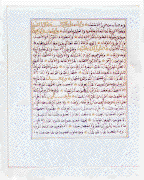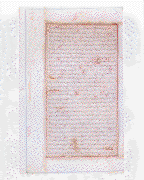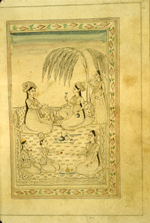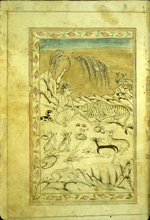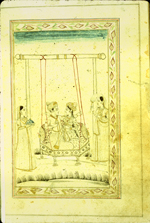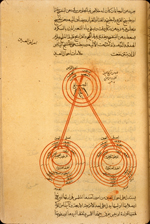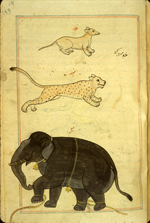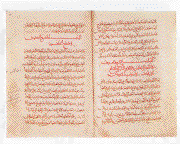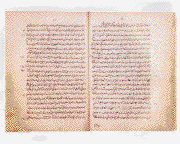Islamic Culture and the Medical Arts
Visual Catalog of the Illustrations (Part 6/9)
(Supplementary Illustrations, Part 1/4)
The following material did not appear in the printed brochure accompanying the original exhibit, although some of the images may have appeared in the exhibit in the form of originals or reproductions.
From the alchemical treatise,
Kitāb al-Burhān fī asrār ‘ilm al-mīzān (The Book of the Proof Regarding the Secrets of the Science of the Balance) by `Izz al-Din Aydamir al-Jildaki, d. 1342.
Undated copy made in Morocco in the late 19th century,
NLM MS A 7 pt. 1, fol. 2a.
From the
Kitāb al-Qānūn fī al-tibb (The Canon of Medicine) by Ibn Sina, d. 1037/428 H. A rare complete copy made in Iran probably at the beginning of the 15th century.
NLM MS A 53, fol. 369a.
One of several illustrations accompanying anonymous poetry. Undated: possibly 18th cent. India, possibly Kashmir.
NLM MS P 24, fol. 15b.
One of several illustrations accompanying anonymous poetry. Undated: possibly 18th cent. India, possibly Kashmir.
NLM MS P 24, fol. 18a.
One of several illustrations accompanying anonymous poetry. Undated: possibly 18th cent. India, possibly Kashmir.
NLM MS P 24, fol. 22b.
Illustration from the ‘Ajā’ib al-makhlūqāt wa-gharā’ib al-mawjūdāt (Marvels of Things Created and Miraculous Aspects of Things Existing) composed in the 13th cent. by Zakariya' ibn Muhammad al-Qazwini. Undated: possibly produced in provincial 18th cent. Mughal India, possibly Punjabi.
NLM MS P 2, fol. 187b.
Eye diagram in red and black ink. From an abridgement of the Qanun (Canon) of Ibn Sina by Ibn al-Nafis. Possibly 17th cent.
NLM MS A 43, fol. 50a.
Illustration from the ‘Ajā’ib al-makhlūqāt wa-gharā’ib al-mawjūdāt (Marvels of Things Created and Miraculous Aspects of Things Existing) composed in the 13th cent. by Zakariya' ibn Muhammad al-Qazwini. Undated: possibly produced in provincial 18th cent. Mughal India, possibly Punjabi.
NLM MS P2, fol. 171a.
From the Kitāb Kāmil al-sinā‘ah al-tibbīyah (The Complete Book of the Medical Art) by `Ali ibn al-`Abbas al-Majusi, d. 994/384 H. The copy was finished on 15 May 1208 (7 Dhu al-Qa`dah 604 H.)
NLM MS A 26.1, fols. 32b-33a.
From the Mu‘alajat al-amrāḍ al-khaṭirah al-bādiyah ‘alá al-badan min khārij (The Treatment of Dangerous Diseases Appearing Superficially on the Body) by Muhammad ibn al-Hasan ibn al-Kattani, 11th cent. Undated: possibly 18th cent.
NLM MS A 91, p. 26-27.
Last Reviewed: December 15, 2011



